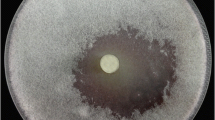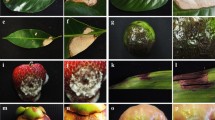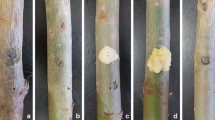Abstract
Extracellular enzymes produced by Metarhizium anisopliae are believed to play a key role in cuticle hydrolysis. The in-vitro production of cuticle-degrading enzymes, such as chitinase, proteinase, caseinase, lipase and amylase in fourteen isolates of M. anisopliae exhibited significant natural isolate variability. The isolates were also evaluated for chitinase and proteinase enzyme assays in order to quantify the enzyme production. The growth characteristics and colony morphology of the isolates showed variation and few isolates formed sectors and the colonies were either fluffy or powdery. Among the isolates studied, isolate UM2 was found to show good consistence with the results on enzyme measurements as well as the growth characteristics and colony morphology. Such characterization of isolate variability could rationally be used in the selection of isolates for the production of improved myco-pesticides in the integrated pest management programs.
Similar content being viewed by others
References
Anil Kondreddy, Seshagirirao Kottapalli, Appa Rao Podile: A simple, rapid and yet less expensive method to detect chitinase in agarose plates. J.Biochem.Biophys.Meth.70, 683–684 (2007).
Bidochka M.J., Khachatourians G.G.: Protein hydrolysis in grasshopper cuticles by entomopathogenic fungal extracellular proteases. J.Invertebr.Pathol.63, 7–13 (1994).
Charnley A.K., St. Leger R.J.: The role of cuticle degrading enzymes in fungal pathogenesis in insects, pp. 267–286 in The Fungal Spore and Disease Initiation in Plants and Animals (G.T. Cole, H.C. Hoch, Eds). Plenum, New York 1991.
Chengshu W., Typas M.A., Butt T.M.: Detection and characterization of Pr1 virulent gene deficiencies in the insect pathogenic fungus Metarhizium anisopliae. FEMS Microbiol.Lett.213, 251–255 (2002).
Clarkson J.M., Charnley A.K.: New insights into the mechanisms of fungal pathogenesis in insects. Trends Microbiol.4, 197–204 (1996).
Fang W., Zhang Y., Yang X., Zheng X., Duan H., Li Y., Pei Y.: Agrobacterium tumefaciens-mediated transformation of Beauveria bassiana using an herbicide resistance gene as a selection marker. J.Invertebr.Pathol.85, 18–24 (2004).
Fang W., Leng B., Xiao Y., Yin K., Ma J., Fan Y., Feng Y., Yang X., Zhang Y., Pei Y.: Cloning of Beauveria bassiana chitinase gene Bbchit1 and its application to improve fungal strain virulence. Appl.Environ.Microbiol.71, 363–370 (2005).
Gohel V., Vyas P., Chhatpar H.S.: Activity staining method of chitinase on chitin agar plate through polyacrylamide gel electrophoresis. African J.Biotechnol.4, 87–90 (2005).
Gupta S.C., Leathers T.D., El-sayed G.N., Ignoffo C.M.: Production of degradative enzymes by Metarhizium anisopliae during growth on defined media and insect cuticle. Exp.Mycol.15, 310–315 (1991).
Gupta S.C., Leathers T.D., El-sayed G.N., Ignoffo C.M.: Insect cuticle-degrading enzymes from the entomogenous fungus Beauveria bassiana. Exp.Mycol.16, 132–137 (1992).
Hegedus D.W., Khachatourians G.G.: Production of an extracellular lipase by Beauveria bassiana. Biotechnol.Lett.10, 637–642 (1988).
Hu G., St. Leger R.J.: Field studies using a recombinant mycoinsecticide (Metarhizium anisopliae) reveal that it is rhizosphere competent. Appl.Environ.Microbiol.68, 6383–6387 (2002).
Inglis G.D., Goettel M.S., Butt T.M., Strasser H.: Use of hyphomycetous fungi for managing insect pests, pp. 23–69 in T.M. Butt, C.W. Jackson, N. Magan (Eds): Fungi as Biocontrol Agents: Progress, Problems and Potential. CABI Publishing, Wallingford (UK) 2001.
Jeffs L.B., Xavier I.J., Mathai R., Khachatourians G.G.: Relationships between fungal spore morphologies and surface property of the genera Beauveria, Metarhizium, Paecilomyces, Tolypocladium and Verticillium. Can.J.Microbiol.45, 936–948 (1999).
Kunitz M.: Crystalline soyabean trypsin inhibitor. II. General properties. J.Gen.Physiol.30, 291–310 (1947).
Milner R.J., Huppatz R.J., Swaris S.C.: A new method for assessment of germination of Metarhizium anisopliae conidia. J.Invertebr. Pathol.57, 121–123 (1991).
Niranjana S.R.: Exploitation of entomopathogenic fungus Beauveria bassiana for efficient control of coffee berry borer in India. J.Mycol.Plant Pathol.34, 714–723 (2004).
Pedrini N., Crespo R., Juarez M.P.: Biochemistry of insect epicuticle degradation by entomopathogenic fungi. Comp.Biochem.Physiol.146, 124–137 (2007).
Reissig J.L., Strominger J.L., Leloir L.F.: A modified colorometric method for the estimation of N-acetylamino sugars. J.Biol.Chem.217, 959–966 (1955).
Shah F.A., Pell J.K.: Entomopathogenic fungi as biological control agents. Appl.Microbiol.Biotechnol.61, 413–423 (2003).
Shimahara K., Takiguchi Y.: Preparation of crustacean chitin. Meth.Enzymol.161, 417–423 (1988).
Smith R.J., Pekrul S., Grula E.A.: Requirements for sequential enzymatic activities for penetration of the integument of the corn earworm (Heliothis zea). J.Invertebr.Pathol.38, 335–344 (1981).
St. Leger R.J., Cooper R.M., Charnley A.K.: Cuticle-degrading enzymes of entomopathogenic fungi: cuticle degradation in vitro by enzymes from entomopathogens. J.Invertebr.Pathol.47, 167–177 (1986a).
St. Leger R.J., Charnley, A.K., Cooper R.M.: Cuticle-degrading enzymes of entomopathogenic fungi: synthesis in culture on cuticle. J.Invertebr.Pathol.48, 85–95 (1986b).
St. Leger R.J., Charnley A.K., Cooper R.M.: Cuticle-degrading enzymes of entomopathogenic fungi: mechanisms of interaction between pathogen and insect cuticle. J.Invertebr.Pathol.47, 295–302 (1986c).
St.Leger R.J., Joshi L., Roberts D.W.: Adaptation of proteases and carbohydrases of saprophytic, phytopathogenic and entomopathogenic fungi to the requirements of their ecological niches. Microbiology143, 1983–1992 (1997).
Yanai K., Takaya N., Kojima M., Horiuchi H., Ohta A., Takaki M.: Purification of two chitinases from Rhizopus oligosporus. J.Bacteriol.174, 7398–7406 (1992).
Author information
Authors and Affiliations
Corresponding author
Rights and permissions
About this article
Cite this article
Mustafa, U., Kaur, G. Extracellular enzyme production in Metarhizium anisopliae isolates. Folia Microbiol 54, 499–504 (2009). https://doi.org/10.1007/s12223-009-0071-0
Received:
Revised:
Published:
Issue Date:
DOI: https://doi.org/10.1007/s12223-009-0071-0




